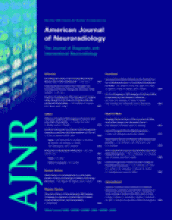As angiographers, we often feel stabs of inadequacy when first reading the many articles promoting the use of CT angiography (CTA) for aneurysm detection. On the basis of the apparently outstanding accuracy of the technique, many centers routinely apply CTA for evaluating patients presenting with subarachnoid hemorrhage.1–3 Management decisions are based on the CTA findings, with direct progression to craniotomy in some or many cases. This imaging and treatment algorithm seems efficient and state-of-the-art for everyone involved. The one individual apparently left out of consideration in this streamlined new-millennium approach is the patient, as far as we can tell.
The most urgent consideration for patients presenting with the suspicion of a ruptured aneurysm is to avoid rehemorrhage, which carries a mortality rate of 80%.4 Unsecured ruptured aneurysms will bleed again frequently. Rates of rehemorrhage are 4% at 24 hours, 20% at 2 weeks, and 50% at 6 months.5 These clinical facts mandate minimizing false-negative rates for any diagnostic examination proposed for imaging patients with suspected ruptured aneurysm. With this in mind, we read with great interest 2 abstracts presented at the 2006 annual meeting of the American Society of Neuroradiology, detailing suboptimal sensitivity of CTA for intracranial aneurysms.6,7 A quick back-of-the-envelope decision analysis, by using the 10% false-negative rate reported in those abstracts applied to a population with 75% prevalence of aneurysms, results in 2.5 additional deaths per 100 patients from rehemorrhage of undiagnosed ruptured aneurysms. Conventional angiography, with near-perfect accuracy and a mortality rate of 0.06%, would result in 0.06 deaths per 100 patients, or less than one fiftieth of the CTA rate.8 For our money, we’ll take conventional angiography any day over CTA.
One could argue that sending all patients with negative findings on CTA on to conventional angiography could “fix” the deficiency of CTA caused by its imperfect sensitivity. We would welcome such a practice pattern. However, we can easily argue that all patients with positive findings on CTA should also go to conventional angiography; this recommendation would mean that every patient with a CTA, positive or negative, should go to conventional angiography.
Patients with CTA examination findings positive for aneurysms should undergo conventional angiography for several reasons. First, most centers now offer endovascular therapy as first-line treatment for ruptured aneurysms. In our opinion, it is difficult or impossible to determine, on the basis of CTA, whether an endovascular approach would be feasible in many cases, and we routinely apply 3D rotational angiography to triage patients to surgery or endovascular treatment. From a purely technical perspective, CTA has a maximum spatial resolution of between 0.35 and 0.5 mm, whereas 3D rotational angiography can resolve vessels between 0.2 and 0.3 mm and conventional digital subtraction angiography (DSA) can resolve vessels as small as 0.1 mm (personal communication, H. Schmitt, PhD, Philips Medical Systems, May 2006). In our opinion, better spatial resolution will naturally lead to improved neck characterization. Recent literature seems to support our bias. Nearly 20% of cases initially thought to be amenable to coiling on the basis of CTA were instead referred for surgery following DSA.2 Furthermore, rates of coiling from series proposing the use of CTA in place of DSA are fairly low, ranging from 20% to 35% of patients being treated with coils rather than surgery.1–3 These low rates of coiling suggest that some patients sent directly to surgery without DSA may have been amenable to coil embolization.
In addition, small important arteries, such as the anterior choroidal artery or the recurrent artery of Heubner, are not identified on CTA. Finally, it remains possible that patients with 1 aneurysm detected on CTA will harbor other undetected aneurysms that were the true source of hemorrhage. Sending such patients directly to surgery, without conventional angiography, leaves these patients at risk for future hemorrhage.
Although we believe CTA is of limited value in a tertiary referral center, there may be reasonable uses for CTA in the other practice environments. For example, if one’s rotational angiography equipment is suboptimal, CTA may assist in determining a working projection for coiling. Also, unstable patients with large intraparenchymal hematomas would benefit from CTA before going directly to surgery. Patients with relatively low pretest probability for aneurysm, such as those with minor trauma, or patients with relative contraindications to angiography, such as patients on warfarin (Coumadin), may reasonably be studied with CTA. In some cases, the choice of anesthesia, either neuroleptic or general, may be based on the probability of detecting an aneurysm, and antecedent CTA may be of benefit. Physicians in hospitals without endovascular therapists might be tempted to perform CTA before transferring patients to appropriate clinical centers that have endovascular capabilities, but even these patients almost certainly will undergo conventional angiography. However, we would argue that all of these instances in which CTA may be reasonable are not usually present in a tertiary care setting.
To review, in the setting of subarachnoid hemorrhage, a negative finding on CTA mandates subsequent conventional angiography on the basis of unacceptable false-negative rates for CTA. Further, a positive finding on CTA also mandates subsequent conventional angiography to further assess aneurysm morphology for triage between endovascular therapy and surgery as well as to detect other aneurysms. If everyone with subarachnoid hemorrhage needs conventional angiography after CTA, then maybe perhaps we should dispense with the CTA all together and just get on with the appropriate test.
References
- Copyright © American Society of Neuroradiology







